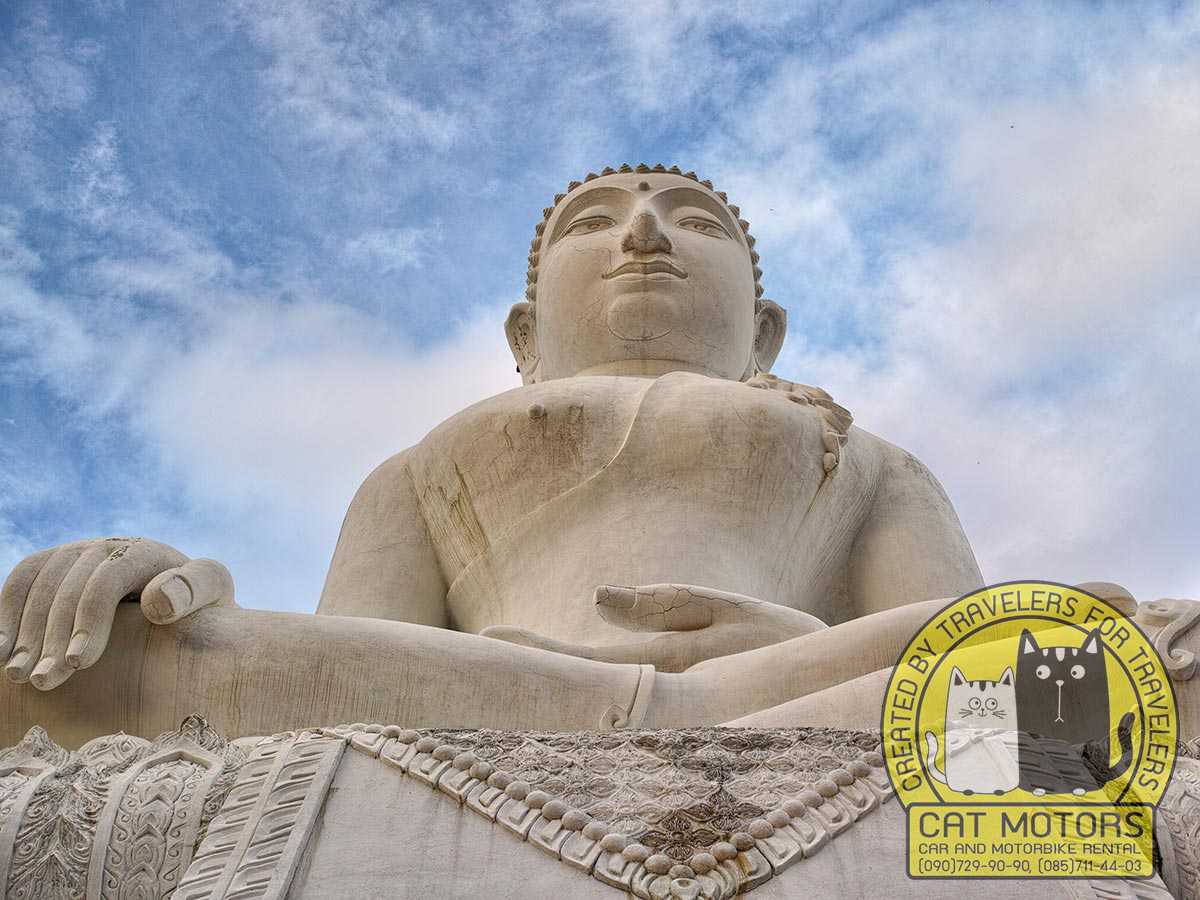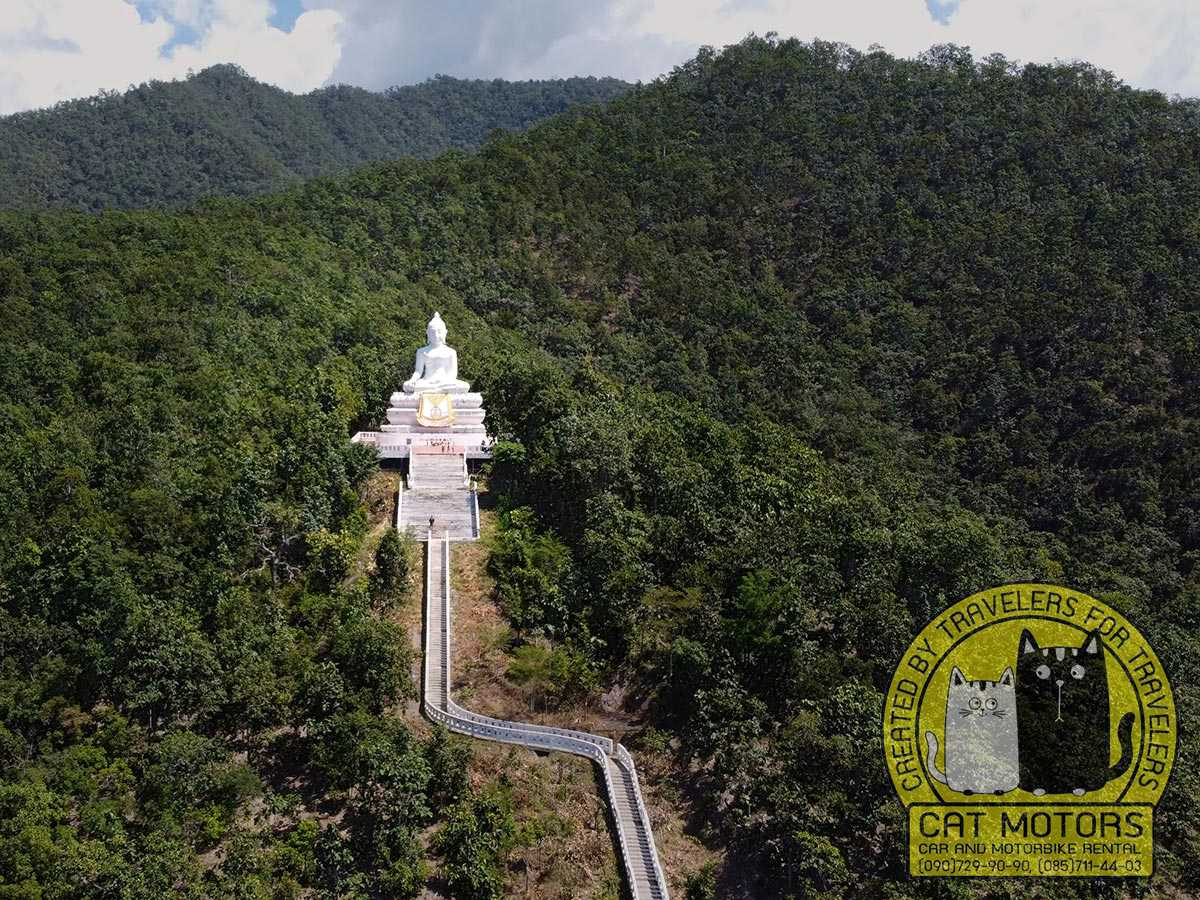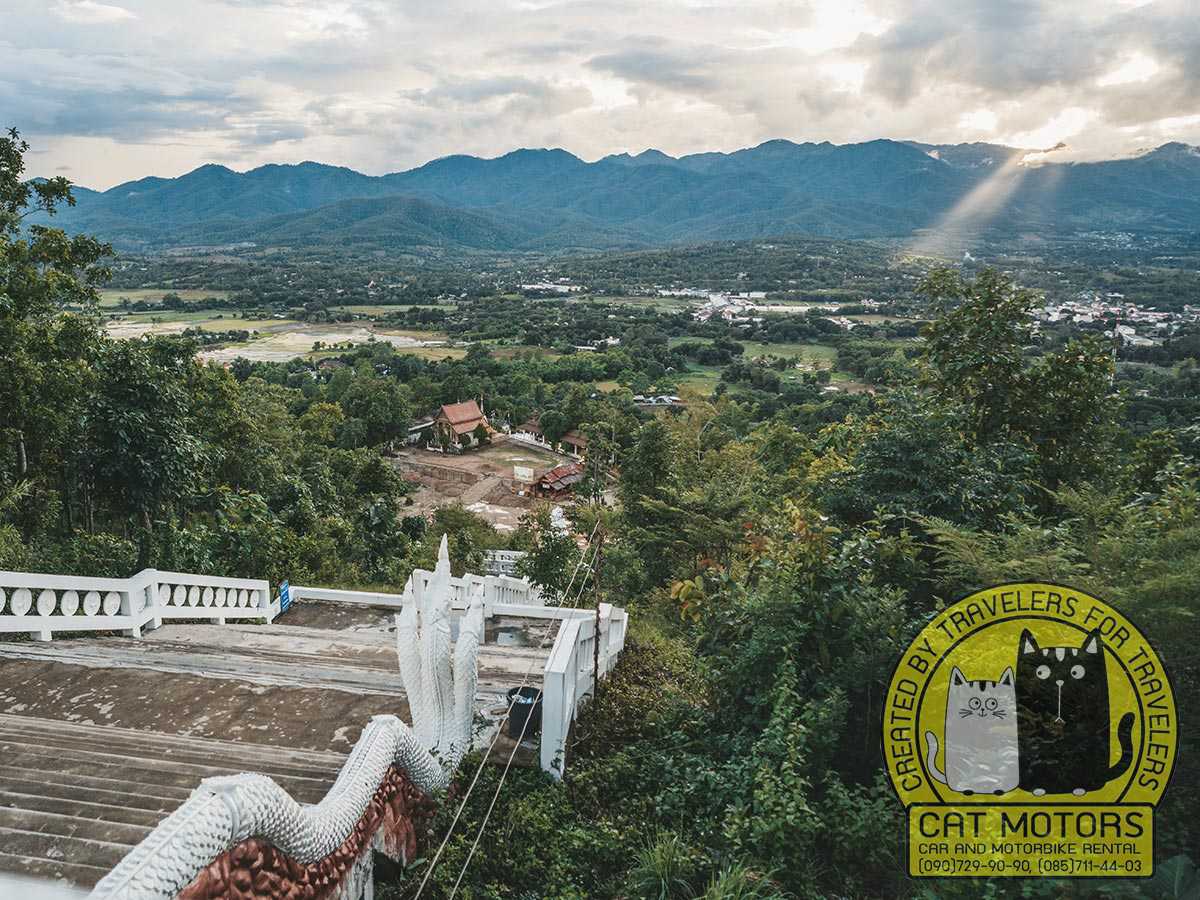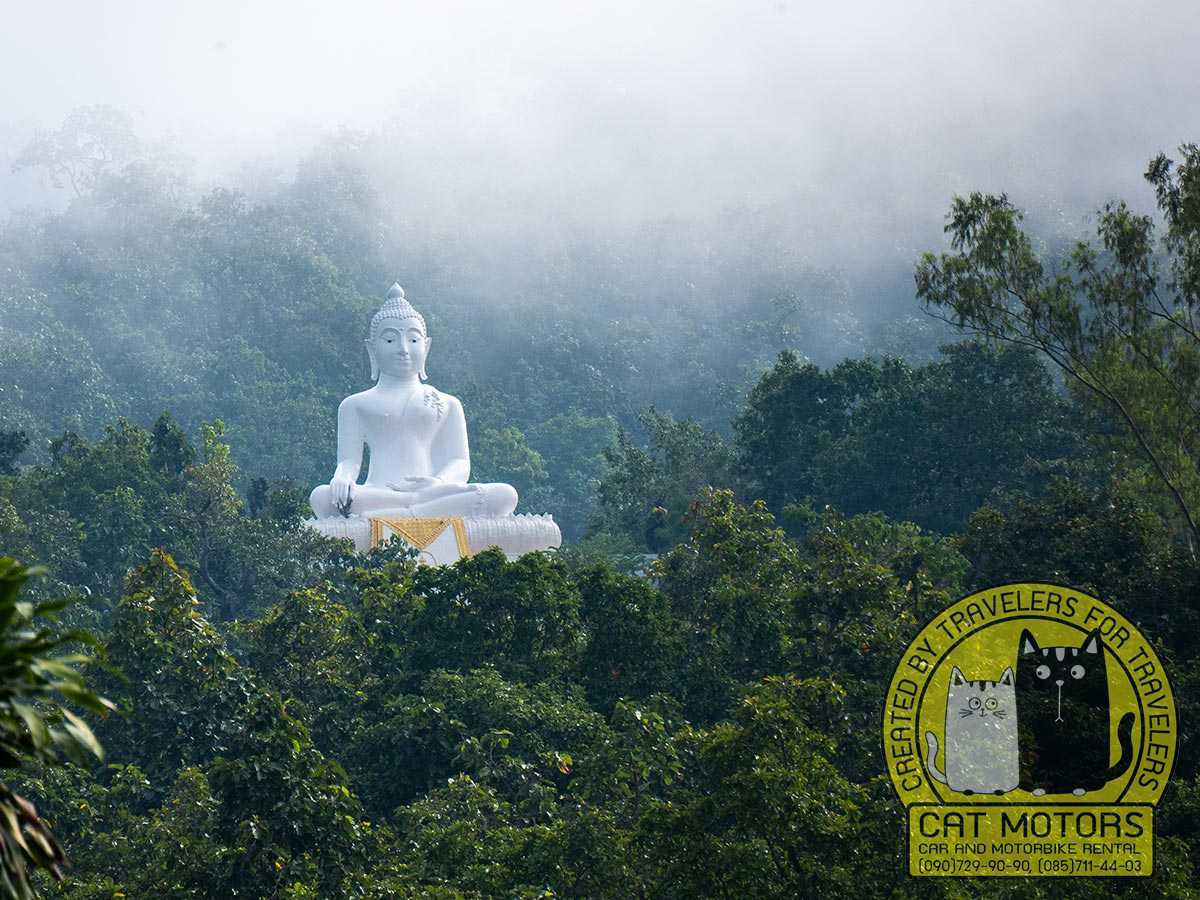Explore Pai’s Big Buddha: A Journey to Serene Sanctuary
The Big Buddha in Pai — a name that resonates with grandeur and tranquility—lures visitors to board a remarkable journey. As you ascend the hill, a breathtaking sight awaits: a colossal white statue, majestically positioned atop the lush valley of Pai, contrasting against the vibrant green hues of the surrounding mountains. But what sets the Big Buddha in Pai apart from other statues around Thailand?

This iconic Big Buddha is a part of the Wat Phra That Mae Yen complex and can be seen from almost every turn in Pai. Visitors and travelers come here to gaze at Thailand’s most amazing sunsets and learn about the statue’s origin, design, and significance as one of the largest Buddhas in Thailand.
By climbing the 353 white steps to explore the Big Buddha, you gain a deeper understanding of local beliefs and traditions, serving as a testament to the timeless connection between art and spirituality. You’ll also learn how the white color symbolizes purity and peace in Buddhism and much more. So, read on as the travel guide covers this must-see attraction in Mae Hong Soon Province of northern Thailand.
Unveiling The Timeless Saga: The Statues Origins And Purpose
Both history and culture buffs would be captivated by the tale behind the Big Buddha in Pai, which breathes life into this mesmerizing region.
Marvelously statued within the Wat Phra That Mae Yen complex
(Google Map), the mesmerizing statue in Pai embodies spiritual devotion and artistic grandeur. As you journey up the hill, you return to the 19th century, when this sacred temple first graced the picturesque town of Pai and overlooked the majestic Mae Hong Son valley.
Revered as a testament to the Buddha’s enlightenment and teachings, the temple embodies the essence of Buddhism. The awe-inspiring statue emerged as a visionary undertaking in the late 20th century. It was the brainchild of esteemed monks, local Thai artists, and craftsmen driven by a profound desire to inspire visitors to Pai and illuminate their understanding of Buddhism.
The statue’s creation spanned several years, fueled by the generosity of local residents and curious wanderers alike.
Standing proudly at a staggering height, the Big Buddha casts its serene presence over the landscape. Crafted from concrete and heartened with an unspoiled white marble exterior (also a tribute to another name known as The White Buddha Temple), the statue emanates an aura shining with purity and serenity—a visual ode to the core tenets of Buddhism.
Fun fact: The statue depicts the seated Buddha in the “subduing Mara” posture, also known as the “calling the earth to witness” stance. It represents the moment of the Buddha’s enlightenment, where he called upon the earth to bear witness to his triumph over the forces of Mara, symbolizing the victory of wisdom over ignorance.
Beyond its physical presence, the statue profoundly symbolizes the region’s rich history, culture, and spirituality tapestry.
Since its completion, the Big Buddha has become an important spiritual and cultural landmark in Pai, attracting both Buddhist devotees and tourists seeking tranquility and scenic views. Locals often visit the site to pay their respects and engage in religious activities, such as offering prayers, lighting incense, and making merit.
A Sacred Pilgrimage: Guide To Visiting The Big Buddha
Getting to the Big Buddha in Pai is an adventure in itself! Pai is nestled in the scenic Mae Hong Son Province of northern Thailand and around 146 km (91 mi) from Chiang Mai along the scenic northern route to Mae Hong Son. You can choose to cycle, walk, or ride a scooter from the vibrant town of Pai. It’s a mere 2.5 km (1.5 miles) journey from the end of Walking Street.
Once you pass the Sunset Viewpoint (Google Map) and Chang Puak Coffee House (Google Map), brace yourself for a short winding road toward the grand entrance. Look out for the temple gateway on the left side adorned with a sign for Wat Phra That Mae Yen.
Climbing The Stairway To Serenity
Once you get there, prepare to conquer 353 steps that lead you to the captivating presence of the Big Buddha. Don’t fret; the steps are not as steep as life’s hurdles, but remember to pack water and don your most comfortable shoes.

There are two options to reach the top of Pai’s remarkable masterpiece:
- The Monk’s Trail: If you’re up for a hike and want a first-hand experience of the Monks’ journey, this option is perfect for you. The trail begins earlier on the road (Google Map), leading you through nature and a longer stairwell towards the temple area before you embark on the mouth of the famous white staircase that ascends to the top of the attraction.
- Visitors Walk: For those who prefer a more direct route or are short on time, the Visitors Walk (Google Map) is an ideal choice. This option allows tourists and locals to head straight to the mouth of the main stairway, conveniently located along the main road. By opting for this route, you can skip the Monk’s Trail and proceed directly to the staircase that leads to the hill’s summit.
Whichever path you choose, the Big Buddha in Pai promises a rewarding experience, whether you opt for the scenic Monk’s Trail or the convenient Visitors Walk.
Note: you would also see blue signs asking visitors to please dress modestly and politely before entering – no tank tops, tight pants, or clothes that are too revealing – as you’re about to enter a sacred realm. Before engaging the stairwell, you can also rent a sarong (a “Pa Kao Mah”) for around 20 baht at the foot of the main temple on the hill.
A Scenic Ascent And Divine Encounters
As you ascend, you’ll encounter delightful surprises, especially an awe-inspiring white slithering serpent staircase at the mouth of the entrance. Keep your eyes open for smaller décor attached to the sides of the staircase railing, representing many spiritual meanings and more.

Take a moment to revel in the breathtaking views of the surrounding countryside and majestic mountains. Let the beauty of nature and spiritual energy uplift your spirits!
Embracing The Magnificence Of The Big Buddha
Finally, you’ll stand face to face with the majestic Big Buddha, standing tall, radiating serenity and wisdom. Take a leisurely stroll around this exquisite masterpiece, marveling at the intricate details of this gentle giant. The area is replete with Instagram-worthy angles that would make memories for a lifetime.
From the sweeping vistas that frame the majestic statue to the enchanting details that adorn its serene presence, this sacred site offers a visual feast that will leave you awestruck. What’s more, you also have access to some of the most striking views of the valley – and if you manage your timing right, you’ll see some of the best places to soak in the sunset.
Note: It’s a custom and a kind gesture to take off and leave your shoes at the last step before setting foot towards the statue.
Admission Fees And Hours Of Operation
Here’s a delightful twist: visiting Pai and its Big Buddha won’t cost you a dime! That’s right; no entrance fee or ticket is required to experience this divine marvel. However, should you feel inclined to contribute to the temple’s well-being: know that you can donate voluntarily.
Touring hours are from 6 am to 6:30 pm, and to make your pilgrimage truly extraordinary, consider the following tips for an unforgettable experience:
- Set out early or venture forth late in the afternoon for a tranquil visit. Not only will you bask in a peaceful atmosphere, but the cooler temperatures will make climbing the stairs a breeze.
- Capture the most enchanting moments by planning your visit during sunrise or sunset. At the crack of dawn, at about 6 am, you’ll witness nature’s canvas ablaze with breathtaking colors. Alternatively, visit at 5 pm for a front-row seat to the sky’s captivating farewell performance.
- If you want clear vistas and pleasant weather, plan your visit between November and February—the dry season. During this time, rain takes a hiatus, humidity retreats, and temperatures become more inviting. However, be prepared for larger crowds, as this period marks the peak of the tourist season.
- For those captivated by Pai’s lush landscapes and cascading waterfalls, the rainy season from June to October holds its own allure. Though visitor numbers may dwindle during this off-peak period, the Big Buddha and its surroundings retain their magical essence, offering a tranquil retreat amidst nature’s generous embrace.
Overall, it’s best to approach with a mindset that allows you to fully absorb the spiritual atmosphere that envelops the Big Buddha in Pai. Allow the awe-inspiring statue to stir your soul as you marvel at its magnificence. Don’t forget to savor the breathtaking beauty of the surrounding landscape—an earthly companion to your spiritual journey.
Nature's Masterpiece: Scenic Views And Beyond
A trip to Pai rewards you with breathtaking panoramic views and opens a gateway to a realm of captivating attractions in its surrounding embrace. As you ascend the 353 white steps towards the Big Buddha, a vista of Pai town, the Mae Hong Son Valley, and the green mountains unfold before you, painting a picture of natural luxury that will leave you thunderstruck.

Yet, the allure of the Pai’s famous statue extends beyond its awe-inspiring views. Within reach, you’ll discover a wealth of nearby attractions just waiting to be explored on foot or by scooter. That said, some of the most renowned gems include:
- Pai Canyon: A natural marvel boasting narrow ridges, sheer cliffs, and deep valleys. Hiking, photography, and sunset watching find their perfect stage in this enchanting landscape, located approximately 8 kilometers south of Pai on Highway 1095.
- Thom’s Pai Elephant Camp: Being among the very first elephant camps to allow visitors to engage with the gentle giants, you can truly enjoy the wonders of responsible and ethical elephant interaction here.
- Feed, bathe, and play with these majestic creatures in the river, while gaining insights into their history and behavior. Unwind in bungalows or indulge in a mineral hot tub and spa retreat. Discover this oasis just 2 km (1.2 miles) north of Pai on Rungsiyanon Road.
- Santichon Village: Step into a cultural haven showcasing the traditions and lifestyle of the Yunnanese people, who migrated from China to Thailand in the 20th century. Marvel at their distinct houses, costumes, crafts, and delectable cuisine.
- Ride on a human-powered Ferris wheel or visit the Yun Lai viewpoint. Delight in the charm of this village nestled 4 kilometers west of Pai on Mae Hee Road.
- Mor Paeng Waterfall: A haven of serenity where nature’s cascading beauty offers respite from the heat. Swim in the inviting natural pools, glide down smooth rocks, or simply unwind on the lush grassy banks. Discover this hidden gem 9 km (5.5 miles) west of Pai on Mae Hee Road.
These captivating attractions merely scratch the surface of what awaits near Pai’s Wat Phra That Mae Yen. With a multitude of options than the ones listed above, these treasures are easily accessible on foot or by scooter, and many are free or require only a nominal fee.
So rest assured, there’s plenty to see and do in and around the Big Buddha in Pai, where nature’s masterpiece intertwines with cultural delights!
Fueling Your Journey Near The Big Buddha: Places To Eat
The ascent and descent of the stairs to the Revered Buddha can ignite a ravenous appetite, calling for a flavorful way to regain that spent energy in the most delectable corners around Pai. So, for those looking to include a grand taste before and after a grand adventure, keep the following places in mind:
- Earth Tone: A vegetarian cafe and health shop that teases taste buds with fresh, organic, and mouthwatering fare. This is the place in Pai where leafy green salads, hearty sandwiches, flavorful wraps, and sumptuous burgers make their home. Enjoy fragrant curries, comforting soups, invigorating smoothies, rejuvenating juices, and more!
Don’t forget to peruse their homemade products, including kombucha, granola, peanut butter, and coconut oil. Conveniently located at the base of the road leading to the temple stairs, Earth Tone is an ideal spot to refuel before or after your visit to the Big Buddha.
- Cafecito: The vibrant flavors of Mexico at Cafecito, a beloved cafe that excites taste buds with a fresh, organic, and mouthwatering fare. Salads, flavorful tacos, hearty burritos, crispy nachos, savory quesadillas, and tempting chilaquiles are all over the menu (and patrons’ mouths).
With a commitment to catering to diverse dietary needs, Cafecito offers vegetarian, vegan, and gluten-free options. Don’t forget to explore their inviting selection of homemade bread, delectable cakes, and fiery hot sauces. Conveniently close to the famed temple, Cafecito is a must-try!
- Pai Night Market: As daylight fades, the Pai Night Market comes alive. Stalls line the streets, serenaded by the melodies of live music wafting from nearby bars. Treat yourself to the bustling ambiance as you explore many street food delights.
Savor noodles, spring rolls, sticky mango rice, and refreshing smoothies. The market offers a treasure trove of souvenirs, clothing, jewelry, and art. Located on Walking Street, near our favorite Buddha, the Pai Night Market invites you to a feast for the senses!
- Thom’s Pai Elephant Camp: Already a great place to visit while still in Pai, Thom’s Elephant Camp is also a haven for culinary indulgences with a great view. Their restaurant tempts with a delectable fusion of Thai and Western dishes, complemented by refreshing drinks and tasty snacks.
After satisfying your taste buds, you can extend your stay by relaxing in a bungalow or indulging in a mineral hot tub and spa retreat – because why not!
These gastronomic havens near the Big Buddha in Pai merely scratch the surface of the delectable offerings awaiting your exploration. Whatever your palate desires—whether it’s wholesome and healthy, hearty and comforting, or indulgently sweet or spicy—rest assured that you’ll find it in the vibrant gourmet landscape surrounding the nearby attractions in Pai.
Quick Facts
Location: The Big Buddha, also known as Wat Phra That Mae Yen, is situated on a hill just a few kilometers outside the center of Pai, offering stunning panoramic views of the town and surrounding landscapes.
Climb: Reaching the Big Buddha involves a climb of 353 steps, which although can be quite a workout, is a journey worth taking for the rewarding views and tranquility at the top.
Size: The statue stands impressively at approximately 23 meters tall, making it one of the largest representations of Buddha in Northern Thailand.
Meaning: The statue represents the Buddha in the “Maravijaya” attitude, symbolizing enlightenment and victory over Mara.
Best Time to Visit: Early morning or late afternoon are ideal times to visit the Big Buddha. Not only can you beat the heat, but these times also offer a chance to see beautiful sunrise or sunset views.
Cost: Visiting the Big Buddha is free of charge, but donations to the temple are appreciated.
Nearby Attractions: Aside from the Big Buddha, the temple grounds also offer a meditation area, a temple bell, and a small café where you can relax.
Etiquette: As a sacred site, it’s important to dress modestly, covering shoulders and knees, and behave respectfully.
Remember, the Big Buddha in Pai is not just about the statue itself, but the serene, spiritual experience it offers. This, combined with the sweeping views of Pai and the surrounding countryside, makes it a must-visit for any traveler.
Our Summary
As you embark on this unforgettable adventure, may you find solace, inspiration, and a deeper connection to Buddhism and Thai culture. Your visit to the Big Buddha in Pai promises to be a harmonious blend of cultural exploration and spiritual enlightenment — a testament to the dynamic balance of human devotion and the serenity that resides within.
FAQ
Early morning or late afternoon are the best times. You can avoid the midday heat and also get a chance to witness either the sunrise or sunset, which are particularly beautiful from the hilltop location.
The White Buddha is only a few kilometers from Pai’s center. You can easily get there by motorbike, bicycle, or even a leisurely walk if you’re up for it.
The Buddha statue is in the ‘Maravijaya’ attitude, symbolizing the moment of achieving enlightenment and overcoming earthly temptations.
As a sacred site, visitors should dress modestly, covering shoulders and knees, and behave respectfully. Shoes must be removed before entering the temple areas.
Most visitors explore the site independently. However, if you’d like more in-depth knowledge, local tour agencies in Pai offer guided tours around the area that often include the White Buddha.
The temple hosts regular Buddhist ceremonies, and it’s particularly lively during Buddhist holidays such as Vesak. But remember, if you do attend, be respectful as these are religious events.
From the hilltop, you can enjoy a panoramic view of Pai and its beautiful surrounding landscapes, particularly stunning during sunrise and sunset.
Yes, the site has basic facilities including restrooms. There’s also a small café nearby where you can grab a refreshment.
The cool season from November to February is a great time to visit, thanks to the comfortable weather and clear skies. But honestly, the White Buddha is a year-round destination.
The climb involves many stairs and might be challenging for those with mobility issues. However, the steps are well-maintained and have railings for support.
Absolutely, besides the White Buddha, Pai Canyon, Pai Hot Springs, and the charming Pai Walking Street are other attractions that you shouldn’t miss.
On average, I’d recommend allotting about 1-2 hours for your visit. This gives you plenty of time to climb, explore, and soak up the views and atmosphere.
Explore Northern Thailand’s stunning landscapes and vibrant culture with our comprehensive travel guides. Highlighting the best scenic routes and local attractions, our guides ensure you experience the best the region has to offer. Start by visiting our big bike rental in Chiang Mai. Be sure to review our terms and conditions for a seamless experience. With these resources, you can explore mountain trails and charming villages with confidence.
Our travel advice sections offer essential tips on staying safe and enjoying your trip to the fullest. Discover the best times to visit major attractions, learn about local festivals, and find out how to handle different road conditions. These insights will make your journey richer and more enjoyable. Join us in uncovering the breathtaking beauty and rich culture of Northern Thailand, ensuring a safe and memorable adventure.
- Author: Krit Sorenser
- Updated: 22/06/2025
- No Comments




